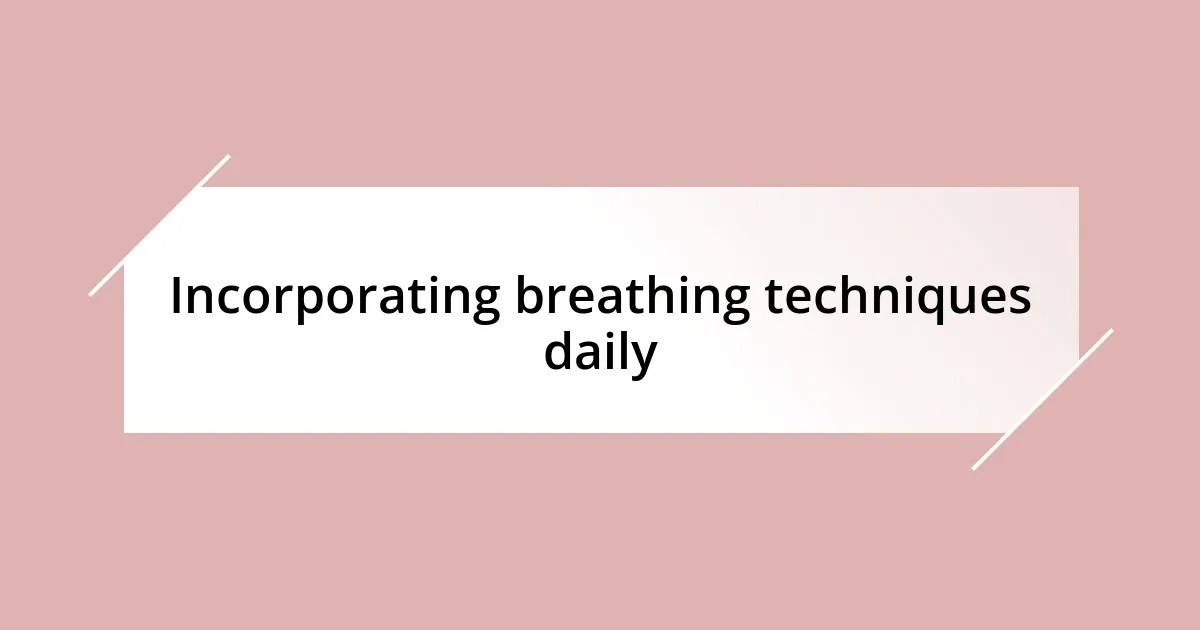Key takeaways:
- Breathing techniques, such as the 4-7-8 and box breathing methods, can significantly reduce anxiety and enhance emotional well-being.
- Incorporating breathing practices daily transforms stress management and improves focus, creating a sense of calm and mental clarity.
- Tracking progress with breathing exercises reveals patterns in emotional responses, empowering individuals to better handle stress over time.
- Overcoming obstacles, both mental and physical, is part of the journey in mastering breathing techniques, leading to profound personal growth.

Understanding breathing techniques
Breathing techniques are more than just methods for taking in air; they can profoundly impact our physical and emotional well-being. I remember a time when I was overwhelmed with stress before a big presentation. I felt the knots in my stomach and my breath becoming shallow. That’s when I turned to deep breathing exercises, finding that just a few minutes of focused breathing helped clear my mind and calm my nerves.
What fascinated me about breathing techniques is how simple yet effective they can be. For instance, the 4-7-8 technique, where you inhale for four seconds, hold for seven, and exhale for eight, transformed my approach to anxious moments. It’s incredible how a structured breathing pattern can change your body’s response to stress—almost like flipping a switch. Have you ever felt that rush of calm wash over you after a few mindful breaths?
Moreover, there’s a beautiful connection between breath and emotion that I’ve come to appreciate. I’ve stood on mountaintops, breathing in crisp air, and feeling an overwhelming sense of connection to nature. Each breath can evoke powerful feelings of peace or even energize you. I wonder, how often do we pause to acknowledge the impact of our breath on our everyday emotions? Breathing techniques serve as a reminder that the simplest actions can lead to significant personal transformation.

Benefits of breathing techniques
The benefits of breathing techniques go beyond mere relaxation; they can enhance physical health as well. For example, I noticed that practicing diaphragmatic breathing regularly improved my lung capacity. It’s amazing how something as fundamental as our breath can have a profound effect on our overall vitality. I didn’t just feel better; I had more energy to tackle gym sessions. Isn’t it interesting to think how often we overlook our breath as a powerful tool in our wellness toolkit?
In addition, there’s a clear link between mindful breathing and improved mental clarity. I recall moments during long workdays when stress clouded my focus. Just a few minutes of stretched inhaling and exhaling restored my concentration, allowing me to return to tasks with renewed vigor. It’s almost like a mental reset button. Have you experienced that sensation of clarity after taking a moment to breathe deeply?
Lastly, let’s not ignore the emotional benefits that come with controlled breathing. There were times when anxiety felt suffocating, leaving me anxious and restless. I utilized rhythmic breathing to ground myself during those overwhelming moments. It’s astonishing how tapping into my breath could bring me back to a serene state, soothing my mind like a gentle wave. It makes you wonder, how many of us could benefit from just a simple pause to breathe more mindfully?
| Benefit | Description |
|---|---|
| Improved Physical Health | Utilizing diaphragmatic breathing can enhance lung capacity and overall energy levels. |
| Mental Clarity | Mindful breathing acts as a reset button, helping to restore focus and concentration. |
| Emotional Stability | Controlled breathing can reduce anxiety levels, bringing about a sense of calm and peace. |

Identifying effective breathing methods
Identifying effective breathing methods can truly be a game changer. I’ve tried various techniques, each offering its own unique benefits. One particularly effective method I found is box breathing. I was skeptical at first, but practicing this method during particularly hectic days helped me regain my composure. It’s as simple as inhaling for four counts, holding for four, exhaling for four, and holding again for four. The rhythm was mesmerizing, almost like a dance that calmed my racing thoughts.
Here’s a quick list of some effective breathing methods I’ve come to appreciate:
- Diaphragmatic Breathing: Engages the diaphragm fully, improving oxygen intake.
- Box Breathing: A structured method that helps stabilize emotions and focus.
- 4-7-8 Breathing: Reduces anxiety by elongating the exhale, promoting relaxation.
- Nadi Shodhana (Alternate Nostril Breathing): Promotes balance and tranquility through nostril alternation.
- Pursed Lip Breathing: Helps slow down the breathing rate and enhances airflow.
Each method not only provided immediate relief but also contributed to a growing sense of awareness about the power of breath in everyday life. I recall sitting in my car, applying the 4-7-8 technique before venturing into a challenging meeting. It felt like pressing the reset button; the calm washed over me, reinvigorating my confidence. Understanding and identifying these techniques has become essential in my self-care routine, transforming how I navigate stress and anxiety.

Incorporating breathing techniques daily
Incorporating breathing techniques into my daily routine has been a transformative experience. I often find myself setting reminders on my phone for short breathing sessions throughout the day, especially when I feel that creeping tension in my shoulders. Sometimes, it’s just a minute of focused breath work, and I can feel the shift in my mindset almost immediately. Have you ever noticed how something so simple can become a sanctuary in the chaos of life?
I also make it a habit to practice my breathing techniques first thing in the morning. This helps me start the day on a grounded note. The other day, I woke up feeling a bit overwhelmed with my to-do list, but just five minutes of deep breathing put everything back into perspective. It’s almost like a sacred ritual now; it sets the tone for everything that follows. Do you have a morning routine that centers you?
Lastly, I’ve discovered that combining breathing techniques with other activities, like yoga or even just a walk in nature, amplifies their benefits. I vividly remember a particular walk where I focused on my breath while observing my surroundings. It wasn’t just refreshing—it was enlightening. I realized then that integrating breath work into daily activities can elevate even the simplest moments. Have you ever tried to infuse mindfulness into everyday tasks? It’s a simple adjustment that can significantly enhance your overall experience.

Tracking progress with breathing exercises
Tracking my progress with breathing exercises has been an eye-opening journey. At first, I was focused on just getting the techniques right, but I soon realized that keeping a journal helped me recognize patterns in my emotional responses. After each session, I would jot down how I felt before and after practicing, which often revealed just how much calmer I could be after just a few moments of mindful breathing. Have you ever stopped to reflect on how emotions ebb and flow with your breath?
Noticing subtle changes over time was truly rewarding. After a couple of weeks, I felt more in control during stressful situations—like when I faced an unexpected deadline at work. I recall feeling a wave of anxiety wash over me, but instead of spiraling, I paused for a brief breath session. The relief was palpable, and realizing I could harness that power made me want to continue tracking my journey. How empowering is it to know that you have tools readily available to improve your mental state?
I also experimented with different techniques, noting which ones resonated most deeply with me. One day, after trying alternate nostril breathing for a week, I found myself navigating a crowded subway with much more ease than I ever had before. I felt focused and present, rather than overwhelmed. This type of reflection reinforced my commitment to these practices; every little success built my confidence. Isn’t it fascinating how something as simple as breath can pave the way for such profound personal growth?

Overcoming obstacles in practice
Overcoming obstacles is part of any practice, including breathing techniques. When I first started, distractions would creep in at the most inconvenient moments. There were days when the chatter in my mind felt deafening, and I’d lose track of my breath entirely. I remember sitting there, frantically trying to find my focus, only to realize that it was okay to feel overwhelmed. Instead of fighting it, I learned to acknowledge those thoughts and gently return my attention to my breathing. Have you ever found peace in accepting your distractions instead of pushing them away?
I encountered some physical obstacles as well. Initially, my body resisted stillness; my muscles would tense up, making it hard to relax and breathe deeply. I recall one session where it felt like my chest was a tightly wound spring. But rather than give up, I began to incorporate gentle stretches before breathing practices. This simple shift transformed my experience, allowing me to breathe unimpeded. Isn’t it interesting how addressing the physical can enhance the mental?
There were moments when my progress seemed stagnant or even regressive, which could be incredibly discouraging. I vividly remember a week filled with stress, where I felt like all my efforts to calm myself had crumbled. I opted for a mindful walk instead of my usual routine. It turned out to be a breakthrough; as I focused on my breath and surroundings simultaneously, clarity returned. Sometimes, turning to an alternative approach can unlock the breakthrough you didn’t even know you needed. What unexpected paths have led you to insights in your own practice?

Long-term impact of breathing techniques
The long-term impact of breathing techniques on my overall well-being has been transformative. I vividly recall a particularly challenging phase in my life—a time when everyday stresses felt almost insurmountable. I found myself gravitating toward my breathing practice more than ever, trusting it to guide me through. With consistent effort, I realized that my reactions to stress became less intense over time. Have you noticed how certain practices can change your response to life’s challenges?
As I continued my journey, I understood that these techniques were rewiring my brain’s response to anxiety. I remember a day at work when a significant project suddenly went awry. Instead of succumbing to panic, I recalled my breathing exercises. Taking a moment to breathe deeply allowed me to regain my focus, clear my mind, and tackle the problem with a calm resolve. Isn’t it remarkable how this simple tool has the potential to shift our entire state of mind?
Looking back, the most profound lesson has been the lasting sense of peace I’ve cultivated. There’s now a steady rhythm to my life that keeps me grounded. I can sense an inner tranquility, even during thunderstorms of stress or uncertainty. It’s as if my breathing has become a reliable anchor amidst the chaos. How wonderful is it to know that something so fundamental can empower us to navigate life’s unpredictability with grace?














